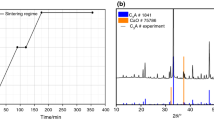Abstract
To use flue gas desulfurization (FGD) gypsum and limestone as supplement of cement, conduction calorimetry was applied to investigate the early hydration of ternary binder of calcium aluminate cement (CAC), Portland-limestone cement (PLC), and FGD gypsum, supplemented with the determination of setting times and X-ray diffraction (XRD) analysis. Different exothermal profiles were presented in two groups of pastes, in which one group (group A) sets the mass ratio of FGD gypsum/CAC at 0.25 and the other group (group B) sets the mass ratio of PLC/CAC at 0.25. Besides the two common exothermal peaks in cement hydration, a third exothermal peak appears in the pastes with 5–15% FGD gypsum after gypsum is depleted. It is found that not PLC but FGD gypsum plays the key role in such ternary binder where the reaction of ettringite formation dominates the hydration process. PLC accelerates the hydration of ternary binder, which mainly attributes to the nucleating effect of fine limestone particles and PC clinker. The modified hydration process and mechanism in this case is well visualized by the means of calorimetry and it helps us to optimize such design of ternary cementitious material.










Similar content being viewed by others
References
Hamm H, Kersten HJ, Hueller R. 25 years experience gained in the European Gypsum Industry with the use of FGD gypsum. Cem Int. 2004;4:92–102.
Guo XL, Shi HS. Thermal treatment and utilization of flue gas desulphurization gypsum as an admixture in the cement and concrete. Constr Build Mater. 2008;22:1471–6.
Tzouvalasl G, Rantis G, Tsimas S. Alternative calcium-sulfate-bearing materials as cement retarders: Part II. FGD gypsum. Cem Concr Res. 2004;34:2119–25.
Glasser FP, Zhang L. High-performance cement matrices based on calcium sulfoaluminate-belite compositions. Cem Concr Res. 2001;31:1881–6.
Péra J, Ambroise J. New applications of calcium sulfoaluminate cement. Cem Concr Res. 2004;34:671–6.
Glasser FP, Zhang L, Zhou Q. Reactions of aluminate cements with calcium sulphate. In: Proceedings of international conference on calcium aluminate cements (CAC), Heriot-Watt University, Edinburgh, Scotland, 2001, pp. 551–64.
Deng M, Tang M. Formation and expansion of ettringite crystals. Cem Concr Res. 1994;24:119–26.
Adams LD. Ettringite, the positive side. In: Proceedings of the 19th international conference on cement microscopy, Cincinnati, Ohio, ICMA, Duncanville, TX, 1997, pp. 1–13.
Amathieu L, Estienne F. Impact of the conditions of ettringite formation on the performance of products based on CAC+CS+OPC. Weimar: 15. Internationale Baustofftagung; 2003. pp. 1-0253–63.
European Committee for Standardization. Cement: composition, specifications and conformity Criteria, Part 1: common Cements, EN 197-1, EN/TC51/WG 6 rev., 2000.
Lothenbach B, Saout GL, Gallucci E, Scrivener K. Influence of limestone on the hydration of Portland cements. Cem Concr Res. 2008;38:848–60.
Poppe AM, Schutter GD. Cement hydration in the presence of high filler contents. Cem Concr Res. 2005;35:2290–9.
Dweck J, Buchler PM, Coelho ACV, Cartledge K. Hydration of a Portland cement blended with calcium carbonate. Thermochim Acta. 2000;346:105–13.
Kuzel HJ, Baier H. Hydration of calcium aluminate cements in the presence of calcium carbonate. Eur J Mineral. 1996;8:129–41.
Darweesh HHM. Limestone as an accelerator and filler in limestone-substituted alumina cement. Ceram Int. 2004;30:145–50.
Gu P, Beaudoin JJ. A conduction calorimetric study of early hydration of ordinary Portland cement/high alumina cement pastes. J Mater Sci. 1997;32:3875–81.
Evju C. Initial hydration of cementitious systems using a simple isothermal calorimeter and dynamic correction. J Therm Anal Calorim. 2003;71:829–40.
Pacewska B, Blonkowski G, Wilińska I. Investigations of the influence of different fly ashes on cement hydration. J Therm Anal Calorim. 2006;86:179–86.
Baert G, Hoste S, De Schutter G, De Belie N. Reactivity of fly ash in cement paste studied by means of thermagravimetry and isothermal calorimetry. J Therm Anal Calorim. 2008;94:485–92.
Rahhal V, Cabrera O, Talero R, Delgado A. Calorimetry of portland cement with silica fume and gypsum additions. J Therm Anal Calorim. 2007;87:331–6.
Rahhal V, Talero R. Calorimetry of Portland cement with metakaolins, quartz and gypsum additions. J Therm Anal Calorim. 2008;91:825–34.
Roszczynialski W, Nocuń-Wczelik W. Studies of cementitious systems with new generation by-products from fluidized bed combustion. J Therm Anal Calorim. 2004;77:151–8.
Sawków J, Nocuń-Wczelik W. Calorimetric studies of refractory corundum calcium aluminate composites. J Therm Anal Calorim. 2003;74:451–8.
Gawlicki M, Nocuń-Wczelik W, Bąk Ł. Calorimetry in the studies of cement hydration. J Therm Anal Calorim. 2009. doi:10.1007/s10973-009-0158-5.
Guan B, Lou W, Ye Q, Fu H, Wu Z, Calorimetric study of calcium aluminate cement blended with flue gas desulfurization gypsum. J Therm Anal Calorim. 2009. doi:10.1007/s10973-009-0107-3.
Scrivener KL. High-performance concretes from calcium aluminate cement. Cem Concr Res. 1999;29:1215–23.
Gu P, Fu Y, Xie P, Beaudoin JJ. A study of the hydration and setting behavior of OPC-HAC paste. Cem Concr Res. 1994;24:682–94.
Taylor HFW. Cement chemistry. 2nd ed. London: Thomas Telford; 1997.
Smrčková E, Palou M, Tomková V. Application of conduction calorimetry for study of the reactivity of C2S–C4A3Ŝ–CŜ–H. J Thermal Anal. 1996;46:597–605.
El-Didamony H, Khalil KA, El-Atter MS. Physicochemical characteristics of fired clay-limestone mixes. Cem Concr Res. 2000;30:7–11.
Regourd M, Thomassion JH, Baillif P, Touray JC. Study of the early hydration of Ca3SiO5 by X-ray photoelectron spectrometry. Cem Concr Res. 1980;10:223–30.
Acknowledgements
The authors acknowledge greatly the financial support of this work by the fund of Chinese National Program for High Technology Research and Development (Project No. 2006AA03Z385), Science and Technology Plan of Zhejiang Province, China (Project No. 2007C23055) and the New Century 151 Talent Project of Zhejiang Province.
Author information
Authors and Affiliations
Corresponding author
Rights and permissions
About this article
Cite this article
Lou, W., Guan, B. & Wu, Z. Calorimetric study of ternary binder of calcium aluminate cement, Portland-limestone cement and FGD gypsum. J Therm Anal Calorim 101, 119–127 (2010). https://doi.org/10.1007/s10973-009-0542-1
Received:
Accepted:
Published:
Issue Date:
DOI: https://doi.org/10.1007/s10973-009-0542-1




